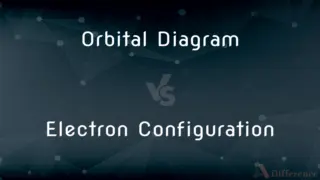Encephalocele vs. Anencephaly — What's the Difference?
Edited by Tayyaba Rehman — By Urooj Arif — Updated on May 9, 2024
Encephalocele involves a sac-like protrusion of the brain through a skull defect, whereas anencephaly is a fatal condition characterized by the absence of major portions of the brain, skull, and scalp.

Difference Between Encephalocele and Anencephaly
Table of Contents
ADVERTISEMENT
Key Differences
Encephalocele is a neural tube defect characterized by the herniation of brain tissue and membranes through an opening in the skull, while anencephaly involves a more severe form of neural tube defect where there is a substantial absence of the brain and skull.
Babies born with encephalocele may have a variable prognosis depending on the location and size of the herniation; on the other hand, anencephaly results in stillbirth or death shortly after birth due to the critical nature of the missing brain structures.
In encephalocele, surgery can sometimes repair the skull defect and reposition the herniated tissue, whereas, in anencephaly, there is no treatment available due to the extensive absence of brain and cranial structures.
The diagnosis of encephalocele is typically made through prenatal ultrasound, showing a clear protrusion or defect in the skull, whereas anencephaly is diagnosed when ultrasounds reveal an almost complete lack of the cranial vault and exposed brain tissue.
The outcomes for encephalocele can range from minimal disability to significant neurological impairment, while anencephaly invariably leads to non-viability of the infant, with no possibility of sustained life.
ADVERTISEMENT
Comparison Chart
Definition
Protrusion of brain tissue through skull defect
Absence of major brain and skull parts
Prognosis
Variable, can be improved with surgery
Fatal, incompatible with sustained life
Treatment
Surgical correction possible
No treatment possible
Diagnostic Method
Prenatal ultrasound, MRI
Prenatal ultrasound
Outcome
Ranges from minimal to severe disability
Always results in death shortly after birth
Compare with Definitions
Encephalocele
Possible surgical intervention.
Surgical intervention in encephalocele aims to reposition the herniated tissues and repair the skull.
Anencephaly
Absence of a major portion of the brain, skull, and scalp.
Anencephaly is characterized by the significant absence of the brain and parts of the skull.
Encephalocele
Can involve meninges and CSF.
In some encephalocele cases, meninges and cerebrospinal fluid also herniate through the skull opening.
Anencephaly
No possibility of treatment.
Due to the severe brain deficiency, there is no treatment available for anencephaly.
Encephalocele
Herniation of brain tissue.
The newborn was diagnosed with an encephalocele, showing brain tissue protruding from the skull.
Anencephaly
Detected through prenatal care.
Routine prenatal ultrasounds can detect anencephaly early in the pregnancy.
Encephalocele
Neural tube defect involving the skull.
Encephalocele is a result of a neural tube defect that affects the skull formation.
Anencephaly
Results in stillbirth or death shortly after birth.
Infants with anencephaly are typically stillborn or die shortly after birth.
Encephalocele
Associated with genetic factors.
Genetic studies suggest a link between familial history and the occurrence of encephalocele.
Anencephaly
Associated with folic acid deficiency.
A deficiency in folic acid during pregnancy is linked to a higher risk of anencephaly.
Encephalocele
Encephalocele is a neural tube defect characterized by sac-like protrusions of the brain and the membranes that cover it through openings in the skull. These defects are caused by failure of the neural tube to close completely during fetal development.
Anencephaly
Anencephaly is the absence of a major portion of the brain, skull, and scalp that occurs during embryonic development. It is a cephalic disorder that results from a neural tube defect that occurs when the rostral (head) end of the neural tube fails to close, usually between the 23rd and 26th day following conception.
Encephalocele
(medicine) A form of hernia of the brain and its membranes through an opening in the skull.
Anencephaly
Congenital absence of most of the brain and spinal cord.
Encephalocele
Hernia of the brain.
Anencephaly
A lethal birth defect in which most of the brain and parts of the skull are missing; absence of the encephalon.
Encephalocele
Protrusion of brain tissue through a congenital fissure in the skull
Anencephaly
A defect in brain development resulting in small or missing brain hemispheres
Common Curiosities
How are these conditions diagnosed?
Both are diagnosed prenatally via ultrasound, with additional MRI for encephalocele.
Can encephalocele lead to intellectual disability?
Yes, depending on the severity of the brain tissue involved.
What is encephalocele?
Encephalocele is a defect where brain tissue protrudes through a skull opening.
Can encephalocele be treated?
Yes, encephalocele can sometimes be treated surgically.
Are these conditions preventable?
While not entirely preventable, proper folic acid intake can reduce the risk.
How is anencephaly different from encephalocele?
Anencephaly is a more severe condition where significant brain and skull parts are missing.
Is there any treatment for anencephaly?
No, anencephaly is fatal and there is no available treatment.
Why is anencephaly always fatal?
Anencephaly results in the absence of essential brain parts necessary for life.
What are the visible signs of anencephaly?
The most visible sign is a significant absence of the cranial vault above the base of the skull.
Is genetic testing available for these conditions?
Genetic counseling and testing can be considered, especially if there's a family history.
What support is available for parents dealing with these diagnoses?
Support includes genetic counseling, medical guidance, and psychological counseling.
What are the outcomes for infants with encephalocele?
Outcomes can vary widely from minimal to severe disabilities.
Can prenatal care detect these conditions early?
Yes, both conditions can be detected early in pregnancy through routine prenatal care.
Are there any advancements in the treatment of encephalocele?
Advancements in surgical techniques have improved outcomes for some affected by encephalocele.
How common is encephalocele compared to anencephaly?
Encephalocele is less common than anencephaly.
Share Your Discovery

Previous Comparison
Section vs. Compartment
Next Comparison
Headlight vs. LighthouseAuthor Spotlight
Written by
Urooj ArifUrooj is a skilled content writer at Ask Difference, known for her exceptional ability to simplify complex topics into engaging and informative content. With a passion for research and a flair for clear, concise writing, she consistently delivers articles that resonate with our diverse audience.
Edited by
Tayyaba RehmanTayyaba Rehman is a distinguished writer, currently serving as a primary contributor to askdifference.com. As a researcher in semantics and etymology, Tayyaba's passion for the complexity of languages and their distinctions has found a perfect home on the platform. Tayyaba delves into the intricacies of language, distinguishing between commonly confused words and phrases, thereby providing clarity for readers worldwide.














































